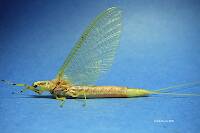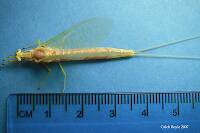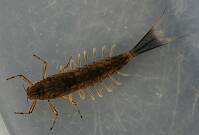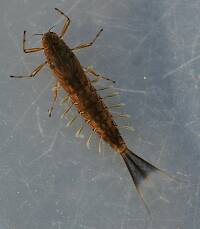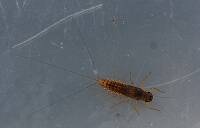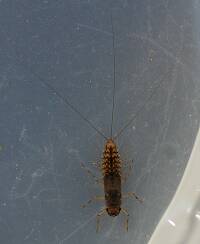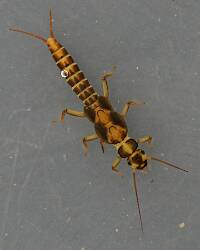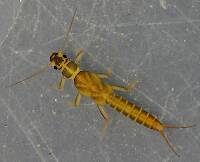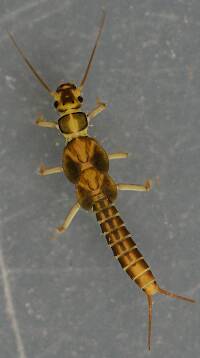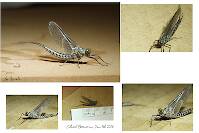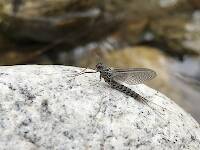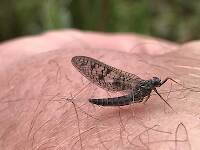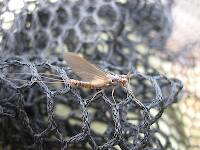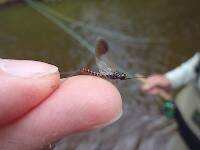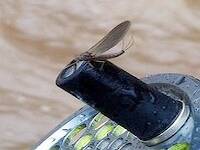
Salmonflies
Pteronarcys californica
The giant Salmonflies of the Western mountains are legendary for their proclivity to elicit consistent dry-fly action and ferocious strikes.
Featured on the forum

This dun emerged from a mature nymph on my desk. Unfortunately its wings didn't perfectly dry out.

Troutnut is a project started in 2003 by salmonid ecologist Jason "Troutnut" Neuswanger to help anglers and
fly tyers unabashedly embrace the entomological side of the sport. Learn more about Troutnut or
support the project for an enhanced experience here.
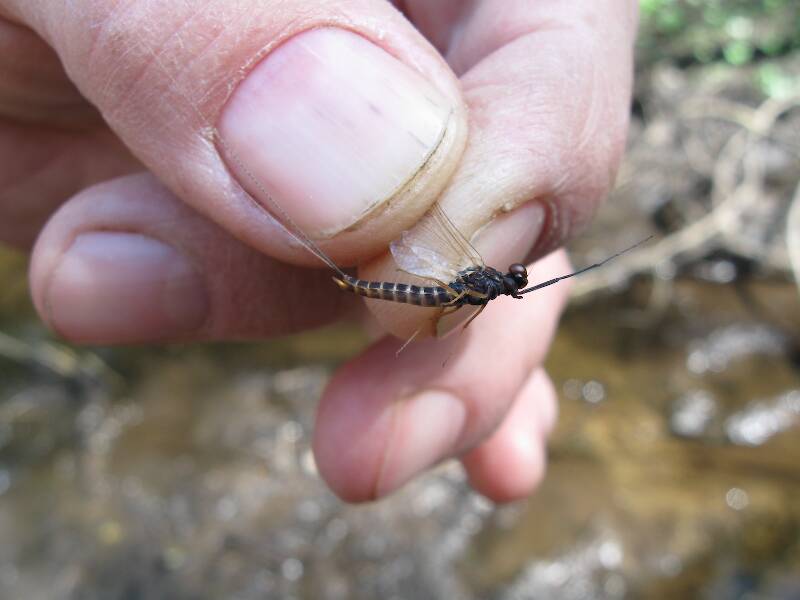
Derdmann on May 28, 2011May 28th, 2011, 2:35 am EDT
Jason,
On May 26th, I was fishing the lower South Branch of the Oconto River. At about 3PM a hatch came off. The bottom was mostly sand and the shore was very silty. The water was 54 degrees. Some of the mayflies were flying over the water and then would hit the stream and appeared to be depositing eggs. Several mangled spinners were also on the stream but no trout were rising to them. www.wiflyfisher.com identified this mayfly as Siplonurus Alternatus. Do you agree? Thanks.
Doug
On May 26th, I was fishing the lower South Branch of the Oconto River. At about 3PM a hatch came off. The bottom was mostly sand and the shore was very silty. The water was 54 degrees. Some of the mayflies were flying over the water and then would hit the stream and appeared to be depositing eggs. Several mangled spinners were also on the stream but no trout were rising to them. www.wiflyfisher.com identified this mayfly as Siplonurus Alternatus. Do you agree? Thanks.
Doug
Gutcutter on May 28, 2011May 28th, 2011, 6:19 am EDT
All men who fish may in turn be divided into two parts: those who fish for trout and those who don't. Trout fishermen are a race apart: they are a dedicated crew- indolent, improvident, and quietly mad.
-Robert Traver, Trout Madness
-Robert Traver, Trout Madness
Troutnut on May 30, 2011May 30th, 2011, 6:22 pm EDT
That's a Siphlonurus spinner, but I don't know which species.
Nevermind, I'm full of it.
Nevermind, I'm full of it.
Jason Neuswanger, Ph.D.
Troutnut and salmonid ecologist
Troutnut and salmonid ecologist
PaulRoberts on May 31, 2011May 31st, 2011, 6:01 am EDT
Why Siphlonurus?
Oldredbarn on Jun 1, 2011June 1st, 2011, 8:26 am EDT
Why Siphlonurus?
Paul...I think I might be with you here...Maybe Leptophlebia...We call it the "Borcher's Drake" or "Black Drake" on the Au Sable...I'll leave the final placement to the "Bug Boys" but the timing could be right for either bug. I can't tell how many tails the bug in the photo has...Leptophlebia has three I think and Siphlonurus two...(?)
If you google Leptophlebia there is a nice photo that looks close...I think the bug up north Michigan is cupida or was so if Mr McCafferty hasn't decided to rename it after himself. :)
Spence
"Even when my best efforts fail it's a satisfying challenge, and that, after all, is the essence of fly fishing." -Chauncy Lively
"Envy not the man who lives beside the river, but the man the river flows through." Joseph T Heywood
"Envy not the man who lives beside the river, but the man the river flows through." Joseph T Heywood
Troutnut on Jun 1, 2011June 1st, 2011, 10:57 am EDT
Actually, I think Spence is right... it is Leptophlebia, not Siphlonurus. Siphlonurus has a distinctive pattern on the eyes that isn't present here. Leptophlebia is supposed to have a third tail, but it's probably just missing from this specimen or not visible in the picture.
Alaska is making me really rusty on my hatches!!
Alaska is making me really rusty on my hatches!!
Jason Neuswanger, Ph.D.
Troutnut and salmonid ecologist
Troutnut and salmonid ecologist
PaulRoberts on Jun 1, 2011June 1st, 2011, 11:32 am EDT
Spence I believe you've got it. Leptophlebia. cupida is the one I've seen in S NY. Very dark and noticeable tergites, the males with big dark eyes.
I've also seen Siphlonurus -quebecensis i believe it was -a very different looking beast, with those bi-colored eyes and fairly rotund somewhat flettened abdomen -like a fat Isonychia. Also with noticeable tergites. Bigger than Leptopphlebia too.
Both are slower water types, but the Siphlonurus takes the prize: The ones I found were in a shallow ditch in a hay field (!) -a good half mile from the nearest stream.
I've also seen Siphlonurus -quebecensis i believe it was -a very different looking beast, with those bi-colored eyes and fairly rotund somewhat flettened abdomen -like a fat Isonychia. Also with noticeable tergites. Bigger than Leptopphlebia too.
Both are slower water types, but the Siphlonurus takes the prize: The ones I found were in a shallow ditch in a hay field (!) -a good half mile from the nearest stream.
Entoman on Jun 1, 2011June 1st, 2011, 3:27 pm EDT
Spence -
So... You ARE a Bugmeister! Out of the closet now, huh?:)
I also agree it's a Leptophlebid male imago. Besides lacking the eye bands of the Siphlonuridae, the segment count of the hind tarsi preclude Heptageniidae (not enough of 'em). The segment ratio of the visible foretarsus is also a useful indicator. Other visual aids are the light rear legs and dark forelegs and overall look/shape of the body. This family seems to have issues with hanging on to their caudal filaments so you were right to ignore that.
Too bad the wings are covered, but it's most likely Leptophlebia cupida (Black Quill, Borcher Drake). It is possible to be nebulosa, johnsoni or perhaps even a few others. Out West we also have the species pacifica that lookes very similar. Perhaps a better look at the nasty bits and wings would help to know which species for sure but regardless, they're all Black Quills.
These are often hard to find as nymphs unless you scoop the slower margins with a net (cut banks are good) in late winter before they start to school up, which leads many to think they are far less important than they can actually be at times. There are pretty good populations of them in waters I fish often, the upper Williamson R. in Oregon for example.
Paul -
Wow, are you right about that! I dread high water that floods the marshes of the upper Williamson. You won't find a Gray Drake nymph anywhere near feeding fish, yet the duns and spinners fill the meadows. Very frustrating...
Regards,
Kurt
So... You ARE a Bugmeister! Out of the closet now, huh?:)
I also agree it's a Leptophlebid male imago. Besides lacking the eye bands of the Siphlonuridae, the segment count of the hind tarsi preclude Heptageniidae (not enough of 'em). The segment ratio of the visible foretarsus is also a useful indicator. Other visual aids are the light rear legs and dark forelegs and overall look/shape of the body. This family seems to have issues with hanging on to their caudal filaments so you were right to ignore that.
Too bad the wings are covered, but it's most likely Leptophlebia cupida (Black Quill, Borcher Drake). It is possible to be nebulosa, johnsoni or perhaps even a few others. Out West we also have the species pacifica that lookes very similar. Perhaps a better look at the nasty bits and wings would help to know which species for sure but regardless, they're all Black Quills.
These are often hard to find as nymphs unless you scoop the slower margins with a net (cut banks are good) in late winter before they start to school up, which leads many to think they are far less important than they can actually be at times. There are pretty good populations of them in waters I fish often, the upper Williamson R. in Oregon for example.
Paul -
Both are slower water types, but the Siphlonurus takes the prize: The ones I found were in a shallow ditch in a hay field (!) -a good half mile from the nearest stream.
Wow, are you right about that! I dread high water that floods the marshes of the upper Williamson. You won't find a Gray Drake nymph anywhere near feeding fish, yet the duns and spinners fill the meadows. Very frustrating...
Regards,
Kurt
"It's not that I find fishing so important, it's just that I find all other endeavors of Man equally unimportant... And not nearly as much fun!" Robert Traver, Anatomy of a Fisherman
Troutnut on Jun 1, 2011June 1st, 2011, 3:35 pm EDT
These are hard to find as nymphs unless...
Really? I've always had a pretty easy time finding them when they're around, in both Wisconsin and New York. I do use a big kick-net, and I generally check slower margins as well as riffles, so maybe that's why.
Jason Neuswanger, Ph.D.
Troutnut and salmonid ecologist
Troutnut and salmonid ecologist
Entoman on Jun 1, 2011June 1st, 2011, 5:21 pm EDT
Hi Jason,
I was adding the word "often" in front of "hard to find" as well as other comments you probably missed while responding as I was editing.:) Accidently posted it before I was ready and I can see how it could have been interpreted as meaning "always".
Still, I think a key point you raised is "when they are around". I'm curious to know when you were finding them easily because of the Leptophlebids habit of schooling prior to and during their seasonal emergence. I believe it is an example of a species that is probably under-sampled a lot if using kicknets or D nets during the spring. Perhaps a more important bug than many think?
My experience with them has taken place in beaver ponds, marshy areas of rivers, and slow undercuts. I haven't found it very easy finding many during their Spring emergence periods. I've occasionally observed their schools while fishing but never with a net in hand as luck would have it.
A side note: They sure swim better than literature says they do. Not Baetid speed maybe but still pretty good. At first glance you think you're seeing a school of tiny minnows. The upper Williamson is thick with them some seasons and actually provide better nymph fishing than the oft mentioned Gray Drake "super hatches" due to the latter's preference to migrate inland into flooded meadow grass or little trickles of irrigation ditches.
Regards,
Kurt
Really? I've always had a pretty easy time finding them when they're around
Still, I think a key point you raised is "when they are around". I'm curious to know when you were finding them easily because of the Leptophlebids habit of schooling prior to and during their seasonal emergence. I believe it is an example of a species that is probably under-sampled a lot if using kicknets or D nets during the spring. Perhaps a more important bug than many think?
My experience with them has taken place in beaver ponds, marshy areas of rivers, and slow undercuts. I haven't found it very easy finding many during their Spring emergence periods. I've occasionally observed their schools while fishing but never with a net in hand as luck would have it.
A side note: They sure swim better than literature says they do. Not Baetid speed maybe but still pretty good. At first glance you think you're seeing a school of tiny minnows. The upper Williamson is thick with them some seasons and actually provide better nymph fishing than the oft mentioned Gray Drake "super hatches" due to the latter's preference to migrate inland into flooded meadow grass or little trickles of irrigation ditches.
Regards,
Kurt
"It's not that I find fishing so important, it's just that I find all other endeavors of Man equally unimportant... And not nearly as much fun!" Robert Traver, Anatomy of a Fisherman
PaulRoberts on Jun 2, 2011June 2nd, 2011, 7:23 am EDT
Interesting. I considered them 'rare' too, and suspected that habitat requirements were tight.
Konchu on Jun 2, 2011June 2nd, 2011, 8:27 pm EDT
Looks like Leptophlebia to me. Can find them in droves in pools left from spring flooding. Most people don't go walking in the woods away from the stream and its pools! Yes, they are quite the swimmers. And the birds and other forest dwellers love them.
Entoman on Jun 3, 2011June 3rd, 2011, 6:17 pm EDT
Jason -
Konchu -
Good stuff! Never found much evidence of them in freestone waters and often tough to find during their hatching period even in the waters mentioned above. Perhaps not always schooled up in a small section as I assumed, but in some isolated pool well back from the bank.
Regards,
Kurt
I generally check slower margins as well as riffles...
Konchu -
Can find them in droves in pools left from spring flooding
Good stuff! Never found much evidence of them in freestone waters and often tough to find during their hatching period even in the waters mentioned above. Perhaps not always schooled up in a small section as I assumed, but in some isolated pool well back from the bank.
Regards,
Kurt
"It's not that I find fishing so important, it's just that I find all other endeavors of Man equally unimportant... And not nearly as much fun!" Robert Traver, Anatomy of a Fisherman
Derdmann on Jun 15, 2011June 15th, 2011, 4:26 am EDT
This mayfly had two tails. Does that change your answer?
PaulRoberts on Jun 15, 2011June 15th, 2011, 8:06 am EDT
No.
I was looking at images of Leptophlebia and it appears that some have a reduced central tail filament (cerci) -easily overlooked against the wrong background. Looks like cupida and nebulosa are this way. Maybe Roger (or others) can weigh in on species in your area. Also, the sand with silt shoreline indicate reduced flow in that stretch -Lepto habitat.
Your bug is NOT Ameletus -a very different looking creature. It's also NOT a Heptagniid, too feeble-legged and wrong body shape. It's not an Ephemerid (burrower) either.
After that, I think we'd be looking at a whole new species -or make that family. :)
Hey, looks like Roger may have already weighed in on this one:
http://www.flyfishingentomology.com/question%20re%20vermont%20mayfly.htm
I was looking at images of Leptophlebia and it appears that some have a reduced central tail filament (cerci) -easily overlooked against the wrong background. Looks like cupida and nebulosa are this way. Maybe Roger (or others) can weigh in on species in your area. Also, the sand with silt shoreline indicate reduced flow in that stretch -Lepto habitat.
Your bug is NOT Ameletus -a very different looking creature. It's also NOT a Heptagniid, too feeble-legged and wrong body shape. It's not an Ephemerid (burrower) either.
After that, I think we'd be looking at a whole new species -or make that family. :)
Hey, looks like Roger may have already weighed in on this one:
http://www.flyfishingentomology.com/question%20re%20vermont%20mayfly.htm
Konchu on Jun 15, 2011June 15th, 2011, 3:27 pm EDT
I briefly posted about the middle tail condition, but then thought of exceptions, had regrets and promptly deleted it, so as not to invoke the ire of the ever-watchful tail-counters on this site (won't mention names). In general, though, I think you're right PaulRoberts. I use that in the field in my area here in Indiana. Just a technical point, though. Cerci are the lateral (side) filaments. The central one is a median filament. There are anatomical consistencies with other insects that make this so.
PaulRoberts on Jun 15, 2011June 15th, 2011, 7:28 pm EDT
... Cerci are the lateral (side) filaments. The central one is a median filament. There are anatomical consistencies with other insects that make this so.
Thanks for that Luke. If I'm going to use exacting words like Cerci, I should certainly understand exactly what they mean.
Entoman on Jun 15, 2011June 15th, 2011, 7:38 pm EDT
Derdmann - This family is notorious for dropped tails in photos. You are as apt to see a photo with one tail or no tails at all as with two or all three. Also, some species have very delicate terminal filaments (central tail) with rather robust cerci to which they often cling. Tail counting is a good start, but can mislead. Without even looking at wings or tails, the dark forelegs and contrasting light middle and rears and solid eyes (lacking the Siphlonurid band) are traits immediatly noticable that clearly differentiate the two.
Luke - Enjoyed your radio interview! Especially your discussion on mosquitos. You had me chuckling to myself as I imagined the reaction of all those Detroit commuters listening in. Only a true Bugmeister would describe the little blood suckers as "good mothers". :) Good stuff.
Kurt.
Luke - Enjoyed your radio interview! Especially your discussion on mosquitos. You had me chuckling to myself as I imagined the reaction of all those Detroit commuters listening in. Only a true Bugmeister would describe the little blood suckers as "good mothers". :) Good stuff.
Kurt.
"It's not that I find fishing so important, it's just that I find all other endeavors of Man equally unimportant... And not nearly as much fun!" Robert Traver, Anatomy of a Fisherman
Derdmann on Jun 16, 2011June 16th, 2011, 4:45 am EDT
Thanks everyone for weighing in. I am trying to learn what is in my streams and you all have been a big help. Now if I can just find a pattern to fool the trout...........
I will be back with more bug ID questions.
Doug
I will be back with more bug ID questions.
Doug
Quick Reply
Related Discussions
Topic
Replies
Last Reply
4
Jun 17, 2020
by Leskorcala
by Leskorcala








